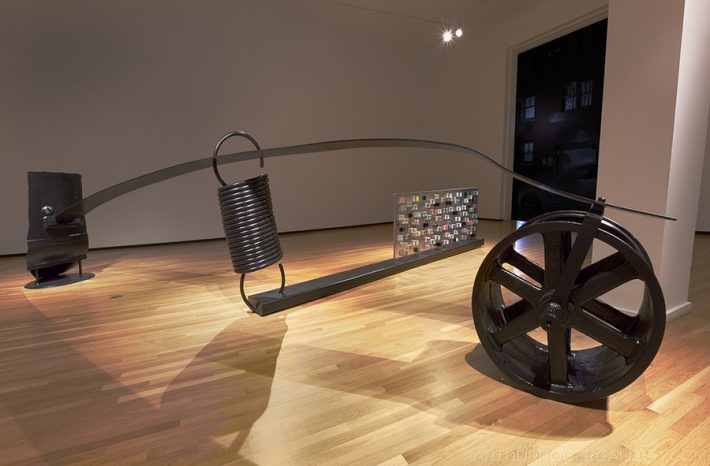Exhibition review by Andrew Page in The UrbanGlass Art Quarterly
ARTHUR ROGER GALLERY
NEW ORLEANS
JANUARY 9-APRIL 10, 2021
Toil (2019-2020), a monumental aluminum, steel, and glass construction that manages to be both elegantly gestural and impressive in scale, stood as the centerpiece of Gene Koss’s eponymously titled exhibition in New Orleans. The massive work, with its two imposing (and opposing) components linked by an Oldenbergian-scale metal spring, is the product of two and a half years of planning and fabrication. Toil may be one of Koss’s most successful efforts to date to articulate and honor the austere dignity that defined agricultural life in the rural Wisconsin to which the artist was born and raised. The work celebrates mechanical ingenuity and the sheer effort required to wrest sustenance from the land while offering a glimpse of the joy found even in such hard life.
The aptly titled Toil features two disparate elements in dialogue; a heavy wheel that, except for its pristine condition, could belong to an antique piece of mechanized farm equipment, is connected to a shovel-like prow by a flat, wide, undulating sheet of steel that flows like a line drawing. A giant spring attaches the plow form to a narrow steel sledge, bearing an aluminum panel shot through by an irregular grid of colorful glass blocks extending out on either side of the metal.
Sketching is a critical part of the process Koss uses to plan and refine his sculptures. Everything he makes begins life as a line on the page, followed by translation into engineering drawings and, often, a maquette, before it finally makes it to a gallery exhibition in finished form (the transport and installation is a feat in itself). At Arthur Roger, the maquette for Toil was also on display on a plinth near the full-scale version, hard evidence of the elaborate production process.
Restraint is a major player in all of Koss’s work, the somber steel surfaces studies in silent strength. But it is in the glass elements that light and color flicker. Koss calls the glass blocks in this work “mosaics,” a reference to the glass-tile compositions that transfixed him as a college student touring Venice. In Toil, Koss’s “mosaics” are not the hand-cut Smalti used in Venetian technique, but rather his own rough-hewn glass castings, which are decidedly non-figurative, offering splashes of light and color instead of imagery. These light-transmitting elements represent what even a hardscrabble life can provide: flashes of joy, pleasure, and levity that glow in contrast with the matte dark steel.
Other works in the exhibition offer further evidence of the evolving maturity of the artist, who has achieved a new level of refined sculptural resolution. There is nothing extra or unnecessary in Furrow (2020), for example – a textured slab of steel with rows of weighty clear glass triangles supported by a row of armatures. It is elegant, and the chunky but controlled glass “plowshares” glowed with potential. In farming, a “furrow” is the line of turned earth awaiting seeds that a plow leaves behind, but it also refers to a deep wrinkle lining a face. An unspoken tension is present in all of Koss’s works, and his art is to give expression to the emotional undertones – the anxieties and the triumphs – in a reticent culture that prefers modesty and silence.
While Koss is known for his large scale, an adjacent smaller gallery showcased a series of all-glass tabletop items, also from 2020. Lined up five deep on opposing walls, the “Ridge Road Climb” series are abstracted clear forms shot through with colored frit. The shapes have an organic quality, as if some type of roots pulled from the earth, which feels like a harvest of exuberance after spending time with the monumental works. They also provide a more accessible (and portable) scale that is a touchstone for the larger work and the aesthetic that produced such notable meditations on man and nature.
ANDREW PAGE, the editor of Glass, reviewed this exhibition virtually due to travel restrictions during the Covid-19 pandemic. Page edited the book Gene Koss: Sculpture (Arnoldsche, 2019).

